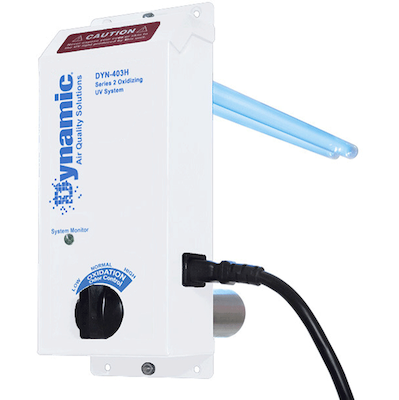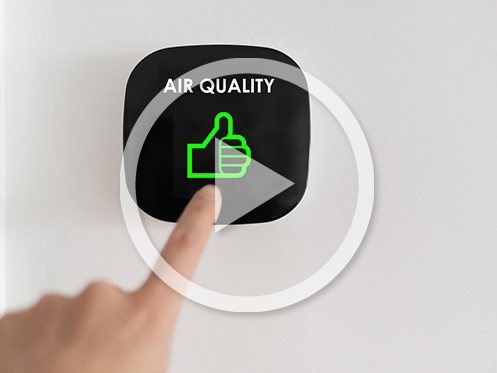Updated January 18, 2024
Indoor air pollution is a severe issue affecting every home, leading to short- and long-term health consequences. You may be surprised to learn that airborne pollution is typically three to five times worse inside a building than outdoor air. This is a worrying statistic, considering that most people spend around 90% indoors. The most effective option for overcoming indoor air pollution and improving the air quality in your home is to install an air purification or filtration system, and this guide will explain all the different options to help you choose the best system for your home.
Media Filters
A media filter is the most basic option for indoor air quality, but this type of unit can still be quite effective. Media filters are typically designed to replace a standard HVAC air filter. Both work the same way by using a physical barrier to trap and remove particles from the air, and the only real difference is that media filters are larger and contain much more efficient filters. A standard air filter is mostly only effective at filtering larger airborne particles like dust, lint, and hair. On the other hand, media filters will also filter out most smaller particles, including pollen, pet dander, fungal spores, etc.
The only real issue with this air cleaner is that the filters are so efficient and densely packed that it is hard for the HVAC air blower to draw air through them. If the blower isn’t working effectively or not powerful enough, you may have issues with reduced airflow that can make your heating and AC less effective. For this reason, you must consult with a technician and choose a filter that matches your blower’s capacity so that the airflow isn’t restricted.
Electronic Air Cleaners
Electronic air cleaners are different from traditional air filters in that they don’t use a physical barrier to trap particles but instead work using electromagnetism. The air cleaner emits charged ions that cling to particles as they enter it. Inside the cleaner are special filter plates with the opposite charge from the ions. Since positive and negative ions attract, all particles stick to the plates and are removed from the air as they pass through the cleaner.
Electronic air cleaners are generally more effective than media filters. Smaller particles can often pass through a standard filter, whereas an electronic air cleaner can capture even the tiniest microscopic particles. Another advantage is that an electronic air cleaner won’t restrict airflow since the air doesn’t have to be drawn through a physical barrier.
HEPA Filtration Systems
A HEPA filter system provides the highest level of filtration available and can remove 99.97% of airborne particles down to 0.3 microns in size. This means that a HEPA filter will capture tiny particles that would typically be able to pass through most other filters. Most HEPA filtration systems are installed in a bypass connected to the existing duct system. A fan inside the system pulls air in from the ductwork and forces it through the filters, and the clean air is then blown back into the ducts. This process is essential for ensuring the system works effectively without restricting airflow.
A HEPA filtration system can be an ideal choice if you or anyone in your household suffers from allergies since it will prevent dust, pollen, pet dander, and all other allergens from circulating your home. The only real disadvantage of HEPA filtration is that it is only effective at filtering out particulates, and many gases, fumes, and chemical pollutants may still pass through the filter.
Whole-Home Air Purification Systems
It is essential to understand the difference between air filtration and air purification. Filtration traps and removes particles from the air, whereas purification sanitizes the air. Many air purifiers work by emitting charged molecules of hydrogen peroxide gas that flow out into the air duct system and are circulated into every room. This type of air purification system actively cleans and sanitizes the air and surfaces in your home instead of simply filtering out particles from the air that flows through the duct system.
Hydrogen peroxide is an extremely powerful ionizer that destroys bacteria, fungal spores, and viruses by damaging the proteins, fats, and carbohydrates in these cells. As the hydrogen peroxide ions circulate in the air, they attract and cling to microorganisms in the air and on any surface and essentially kill them on contact. This process is so effective that many systems have been proven to eliminate more than 99% of all bacteria, viruses, and fungal spores.
The ions also electrostatically charge other airborne particles like dust, pollen, pet dander, and even gaseous chemical pollutants. This charge causes the particles to stick to each other and form large clumps that will more easily get trapped by a standard HVAC air filter. Some clumps also become heavy enough to fall to the floor and other surfaces so that they can easily be removed when you vacuum and mop your floors and dust or wipe down your counters and other surfaces.
One thing to note about this type of air purifier is that the amount of hydrogen peroxide it produces is around 50 times less than the maximum safe level, so you don’t need to worry about it harming your health.
UV Light Purification
UV light purification effectively eliminates microorganisms like bacteria, viruses, and fungal spores from the home to prevent allergy symptoms and help prevent illness. This type of system is installed inside one of the air ducts and emits solid ultraviolet light. When bacteria, viruses, or spores pass through the UV light, their DNA is altered to make them harmless and prevent them from spreading, reproducing, or making you sick.
There are two different types of UV light systems that each serve a slightly different purpose. An air-sanitizing light is designed to destroy microorganisms in the air circulating through your ductwork so that your HVAC system doesn’t blow them around the house. Coil-sanitizing lights, on the other hand, shine the UV rays directly onto the AC evaporator coil to kill and prevent bacteria and mold growth. Bacteria and mold commonly grow on evaporator coils during the warmer months when the AC is running simply because the coil continually stays wet and warm, creating the ideal conditions for these microorganisms to grow and reproduce.
Golden Rule is the HVAC company you can trust for all indoor air quality needs. We provide professional air quality testing services that will help you pinpoint your home’s specific air quality issues. We install and service a wide range of air quality systems, including air cleaners, purifiers, UV lights, and more. We also offer professional heating, cooling, plumbing, and electrical services. For more information on your options, call Golden Rule today.
Contact Us Today for Indoor Air Quality Service!
If you found this post helpful, check out some other budget-saving tips:



